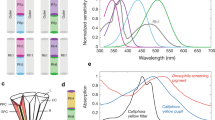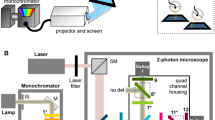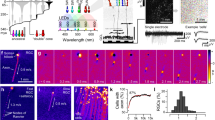Abstract
The recent observation of fluorescence emission from photoreceptor cells in flies1 offers a new opportunity to map the distribution of the various spectral types in a highly organized retinal mosaic. Previous studies had led to the conclusion that in each ommatidium the two central receptor cells are quite distinct from their six neighbours in terms of anatomical projection2,3, visual pigment and physiology4. We show here that in a restricted, well defined region of the male eye only, one of these central cells resembles its six neighbours not only in having the same visual pigment and physiological properties, but also in sending its axon to the same neuropile. A clue to the function of this sexually dimorphic retinal organization is given by the fact that these male-specific cells dominate the frontal-dorsal part of the retina (fovea) which is used by the male to track females in aerobatic chases5,6. We suggest that the male fovea, already known to drive sex-specific higher-order neurones7, has sacrificed colour vision for other more vital kinds of information processing such as improving quantum catch and possibly also contrast transfer or movement detection.
This is a preview of subscription content, access via your institution
Access options
Subscribe to this journal
Receive 51 print issues and online access
$199.00 per year
only $3.90 per issue
Buy this article
- Purchase on Springer Link
- Instant access to full article PDF
Prices may be subject to local taxes which are calculated during checkout
Similar content being viewed by others
References
Franceschini, N., Kirschfeld, K. & Minke, B. Science (in the press).
Cajal, S. R. Trab. Lab. Invest. biol. Univ. Madr. 7, 217–256 (1909).
Trujillo-Cenoz, O. & Melamed, J. in The Functional Organization of the Compound Eye (ed. Bernhard, C. G.) 339–361 (Pergamon, London, 1966).
Hardie, R. C., Franceschini, N. & McIntyre, P. D. J. comp. Physiol. 133, 23–39 (1979).
Land, M. F. & Collett, T. S. J. comp. Physiol. 89, 331–357 (1974).
Wehrhahn, C. Biol. Cybern. 32, 239 (1979).
Hausen, K. & Strausfeld, N. Proc. R. Soc. B208, 57–71 (1980).
Kirschfeld, K. Expl Brain Res. 3, 248–270 (1967).
Braitenberg, V. Expl Brain Res. 3, 271–298 (1967).
Scholes, J. Kybernetik 6, 149–162 (1969).
Boschek, B. Z. Zellforsch. mikrosk. Anat. 118, 369–409 (1971).
McCann, G. D. & Arnett, D. W. J. gen. Physiol. 59, 534–558 (1972).
Kirschfeld, K., Franceschini, N. & Minke, B. Nature 269, 386–390 (1977).
Hardie, R., Franceschini, N., Ribi, W. & Kirschfeld, K. (in preparation).
Franceschini, N. & Hardie, R. C. J. Physiol., Lond. 301, 56P (1980).
Kirschfeld, K. & Wenk, P. Z. Naturf. 31, 764–765 (1976).
Stewart, W. W. Cell 14, 741–759 (1978).
Author information
Authors and Affiliations
Rights and permissions
About this article
Cite this article
Franceschini, N., Hardie, R., Ribi, W. et al. Sexual dimorphism in a photoreceptor. Nature 291, 241–244 (1981). https://doi.org/10.1038/291241a0
Received:
Accepted:
Issue Date:
DOI: https://doi.org/10.1038/291241a0
This article is cited by
-
Opsin knockdown specifically slows phototransduction in broadband and UV-sensitive photoreceptors in Periplaneta americana
Journal of Comparative Physiology A (2022)
-
How do field of view and resolution affect the information content of panoramic scenes for visual navigation? A computational investigation
Journal of Comparative Physiology A (2016)
-
Sexual dimorphism and natural variation within and among species in the Drosophilaretinal mosaic
BMC Evolutionary Biology (2014)
-
Characterisation of a blowfly male-specific neuron using behaviourally generated visual stimuli
Journal of Comparative Physiology A (2007)
-
The bright zone, a specialized dorsal eye region in the male blowflyChrysomyia megacephala
Journal of Comparative Physiology A (1989)
Comments
By submitting a comment you agree to abide by our Terms and Community Guidelines. If you find something abusive or that does not comply with our terms or guidelines please flag it as inappropriate.



